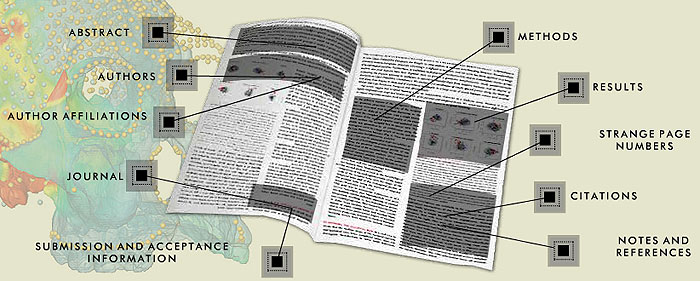|
Sharing Findings: The Anatomy of a Peer-Reviewed Paper
|
|
|
|
How Do Results Get Shared?
Ultimately, science is a group effort. As such, an important final phase of any research project is sharing results with others.
Among colleagues and collaborators, results are often shared informally: hallway chats, e-mails, and phone calls. But to share results formally and be officially recognized for a finding, researchers must publish in a scientific journal.
Articles published in scientific journals follow a regimented format that can be difficult for non-scientists to decode. Let’s take a closer look.
|

|
|
|
ABSTRACT
If you read only one part of a scientific article, make it the abstract. In just one paragraph, the abstract summarizes the entire article, including the purpose of the research, its methods, and results.
|
|
|
AUTHORS
Everyone involved in a research project—absolutely everyone—gets listed among the authors. That’s why you’ll sometimes see 50 or more names here. The first name on the list is generally the person who did most of the work. The last name on the list is also important: this person is often the senior “big name” researcher who oversaw the project.
|
|
|
AUTHOR AFFILIATIONS
Take a look at the Author’s list. If you see little numbers or symbols by people’s names, these refer to a section of notes that identifies official affiliations—the laboratories and institutions sponsoring the research. With this list, you can see details about the scientists and institutions involved and how they collaborated. Contact information is also available here.
|
|
|
JOURNAL
Where an article is published is almost as important as what the article says. Prestigious and selective journals like
Science
and
Nature
will only publish articles that survive the scrutiny of other scientists—a process called peer review. An article in a peer-reviewed journal is generally considered to be more reliable, and often more significant, than one found in a journal without a peer-review process.
|
|
|
SUBMISSION AND ACCEPTANCE INFORMATION
Identifies the paper’s submission and acceptance dates. The submission date establishes priority for major discoveries. The acceptance date—which may be many months later—reveals the time it took for peer review to take place. The publication process may add another month or two before the paper is seen by the public.
|
|
|
METHODS
The devil is in the details. That’s why scientists are most likely to scrutinize this section, which describes the exact procedures followed by the author. Ideally, there should be enough detail given here that another scientist could replicate the experiment. These days, many journals publish in-depth methods information online only, to save space in the printed version.
|
|
|
RESULTS
This section is the heart of the article; here you’ll find the actual research data. In addition to the text, supporting information may take any of various forms: figures, graphs, charts, even photographs.
|
|
|
STRANGE PAGE NUMBERS
Many scientific journals number pages sequentially through an entire year. That means a five-page article may span pages 15–20 if published in January, or 2250–2255 if published in December. This system creates a long-term, unique reference for each paper so its location can be easily tracked and shared. Ultimately, the year’s worth of journal issues will be bound into a book.
|
|
|
CITATIONS
Here you’ll find the most important articles published so far on the topic at hand. Especially important are review articles, articles that summarize and reflect on all the relevant research done so far. Science is a community, and each published article is just one statement in an ongoing conversation between scientists around the world.
|
|
|
NOTES AND REFERENCES
In this section, you’ll find references, resources, and acknowledgments, from thank-you notes to tips on finding suitable strains of mouse DNA.
|
|
|
